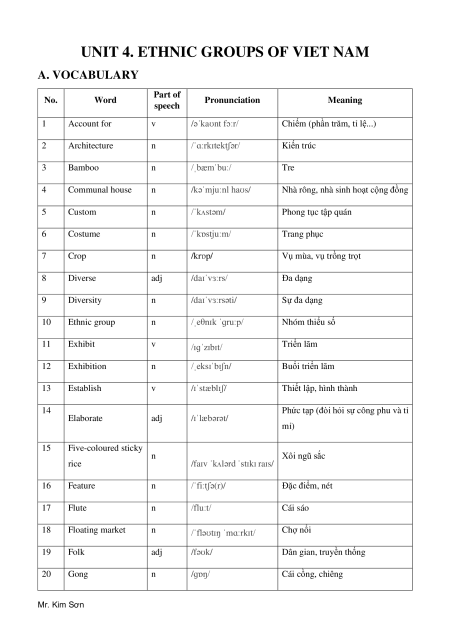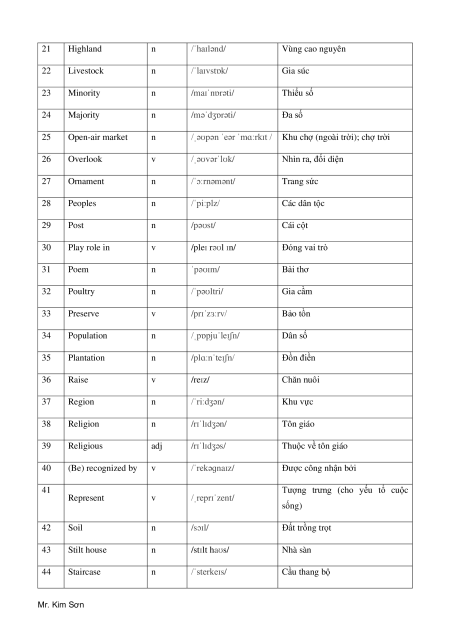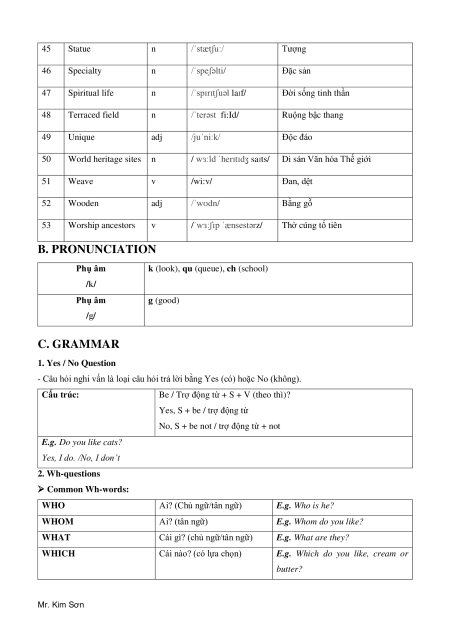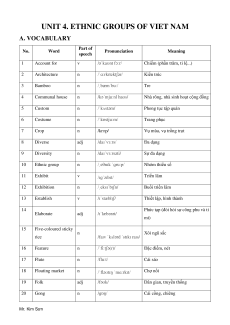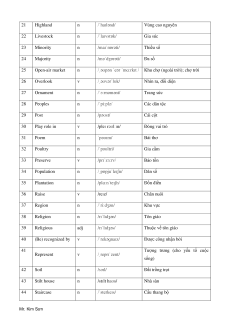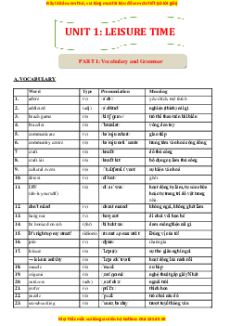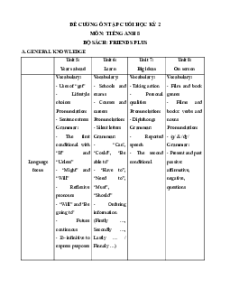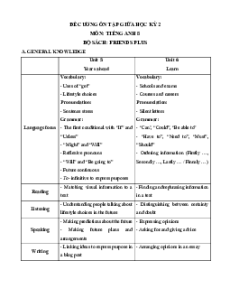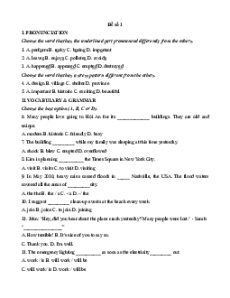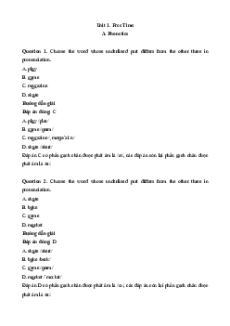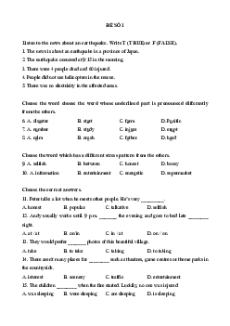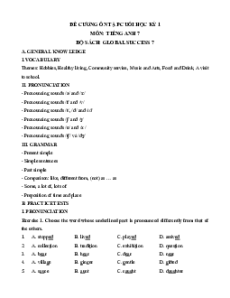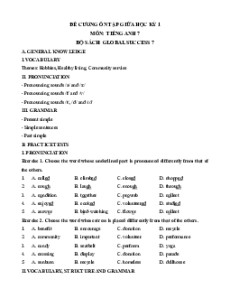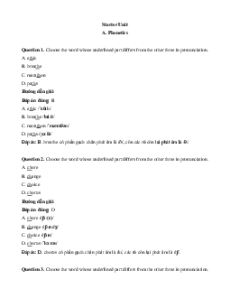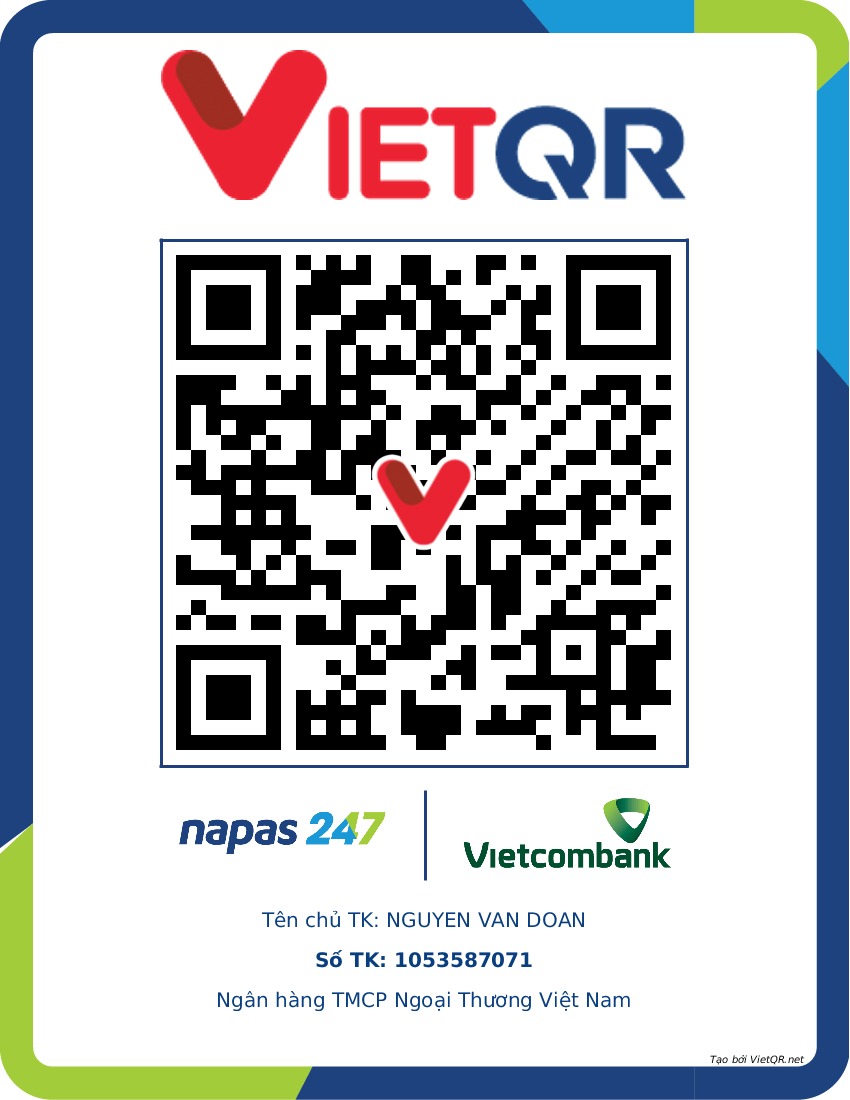UNIT 4. ETHNIC GROUPS OF VIET NAM A. VOCABULARY Part of No. Word Pronunciation Meaning speech 1 Account for v /əˈkaʊnt fɔːr/
Chiếm (phần trăm, tỉ lệ...) 2 Architecture n /ˈɑːrkɪtektʃər/ Kiến trúc 3 Bamboo n /ˌbæmˈbuː/ Tre 4 Communal house n /kəˈmjuːnl haʊs/
Nhà rông, nhà sinh hoạt cộng đồng 5 Custom n /ˈkʌstəm/ Phong tục tập quán 6 Costume n /ˈkɒstjuːm/ Trang phục 7 Crop n /krɒp/
Vụ mùa, vụ trồng trọt 8 Diverse adj /daɪˈvɜːrs/ Đa dạng 9 Diversity n /daɪˈvɜːrsəti/ Sự đa dạng 10 Ethnic group n /ˌeθnɪk ˈɡruːp/ Nhóm thiểu số 11 Exhibit v /ɪɡˈzɪbɪt/ Triển lãm 12 Exhibition n /ˌeksɪˈbɪʃn/ Buổi triển lãm 13 Establish v /ɪˈstæblɪʃ/ Thiết lập, hình thành 14
Phức tạp (đòi hỏi sự công phu và tỉ Elaborate adj /ɪˈlæbərət/ mỉ) 15 Five-coloured sticky n Xôi ngũ sắc rice
/faɪv ˈkʌlərd ˈstɪkɪ raɪs/ 16 Feature n /ˈfiːtʃə(r)/ Đặc điểm, nét 17 Flute n /fluːt/ Cái sáo 18 Floating market n /ˈfləʊtɪŋ ˈmɑːrkɪt/ Chợ nổi 19 Folk adj /fəʊk/ Dân gian, truyền thống 20 Gong n /ɡɒŋ/ Cái cồng, chiêng Mr. Kim Sơn 21 Highland n /ˈhaɪlənd/ Vùng cao nguyên 22 Livestock n /ˈlaɪvstɒk/ Gia súc 23 Minority n /maɪˈnɒrəti/ Thiểu số 24 Majority n /məˈdʒɒrəti/ Đa số 25 Open-air market n
/ˌəʊpən ˈeər ˈmɑːrkɪt / Khu chợ (ngoài trời); chợ trời 26 Overlook v /ˌəʊvərˈlʊk/ Nhìn ra, đối diện 27 Ornament n /ˈɔːrnəmənt/ Trang sức 28 Peoples n /ˈpiːplz/ Các dân tộc 29 Post n /pəʊst/ Cái cột 30 Play role in v /pleɪ rəʊl ɪn/ Đóng vai trò 31 Poem n ˈpəʊɪm/ Bài thơ 32 Poultry n /ˈpəʊltri/ Gia cầm 33 Preserve v /prɪˈzɜːrv/ Bảo tồn 34 Population n /ˌpɒpjuˈleɪʃn/ Dân số 35 Plantation n /plɑːnˈteɪʃn/ Đồn điền 36 Raise v /reɪz/ Chăn nuôi 37 Region n /ˈriːdʒən/ Khu vực 38 Religion n /rɪˈlɪdʒən/ Tôn giáo 39 Religious adj /rɪˈlɪdʒəs/ Thuộc về tôn giáo 40 (Be) recognized by v /ˈrekəɡnaɪz/ Được công nhận bởi 41
Tượng trưng (cho yếu tổ cuộc Represent v /ˌreprɪˈzent/ sống) 42 Soil n /sɔɪl/ Đất trồng trọt 43 Stilt house n /stɪlt haʊs/ Nhà sàn 44 Staircase n /ˈsterkeɪs/ Cầu thang bộ Mr. Kim Sơn 45 Statue n /ˈstætʃuː/ Tượng 46 Specialty n /ˈspeʃəlti/ Đặc sản 47 Spiritual life n /ˈspɪrɪtʃuəl laɪf/ Đời sống tinh thần 48 Terraced field n /ˈterəst fi:Id/ Ruộng bậc thang 49 Unique adj /juˈniːk/ Độc đáo 50 World heritage sites n
/ wɜːld ˈherɪtɪdʒ saɪts/
Di sản Văn hóa Thế giới 51 Weave v /wi:v/ Đan, dệt 52 Wooden adj /ˈwʊdn/ Bằng gỗ 53 Worship ancestors v /ˈwɜːʃɪp ˈænsestərz/ Thờ cúng tổ tiên B. PRONUNCIATION Phụ âm
k (look), qu (queue), ch (school) /k/ Phụ âm g (good) /g/ C. GRAMMAR 1. Yes / No Question
- Câu hỏi nghi vấn là loại câu hỏi trả lời bằng Yes (có) hoặc No (không). Cấu trúc:
Be / Trợ động từ + S + V (theo thì)?
Yes, S + be / trợ động từ
No, S + be not / trợ động từ + not
E.g. Do you like cats?
Yes, I do. /No, I don’t 2. Wh-questions ➢ Common Wh-words: WHO Ai? (Chủ ngữ/tân ngữ) E.g. Who is he? WHOM Ai? (tân ngữ)
E.g. Whom do you like? WHAT
Cái gì? (chủ ngữ/tân ngữ)
E.g. What are they? WHICH Cái nào? (có lựa chọn)
E.g. Which do you like, cream or butter? Mr. Kim Sơn WHERE ớ đâu?
E.g. Where will you go? WHEN Khi nào?
E.g. When did you leave? HOW
Như thế nào? (tính từ) Cách E.g. How are you?
thức? (trạng từ) Phương tiện
E.g. How do you go to school? WHOSE+ N Của ai?
E.g. Whose book is this? WHY Tại sao?
E.g. Why don't you go? WHAT/WHICH + N Hỏi cụ thể danh từ
E.g. What colour do you like? HOW + ADJ/ADV
Hỏi cụ thể tính từ/trạng từ
E.g. How big is it? HOW MANY + Ns/es
Hỏi số lượng (đếm được)
E.g. How many books are there? HOW MUCH+ N
Hỏi số lượng (không đếm E.g. How much beef do you like? HOW MUCH được)
E.g. How much does it cost? Hỏi giá tiền HOW OLD Hỏi tuổi
E.g. How old is she? HOW LONG Hỏi thời gian bao lâu
E.g. How long does it take you? Hỏi chiều dài
E.g. How long is the ruler? HOW OFTEN Hỏi tần suất
E.g. How often do you dine out? HOW FAR Hỏi khoảng cách
E.g. How far is it? HOWTALL/HIGH Hỏi chiều cao/độ cao
E.g. How tall are you?
➢ How to make a W-H question (Cách đặt câu hỏi)
Dạng 1: Câu hỏi chủ ngữ chỉ người Who + V+ ...?
E.g. Who lives in London with Daisy?
Dạng 2: Câu hỏi cho động từ
What + am / is / are I will / can / may / should / do / does / did + S + do (theo thì)?
E.g. What are you doing now? I’m drawing.
E.g. What does your mother do in her free time? She watches TV.
E.g. What can they do? Mr. Kim Sơn
Bài tập chuyên sâu Unit 4: Ethnic groups of Viet Nam Tiếng Anh 8 Global success
2.5 K
1.2 K lượt tải
MUA NGAY ĐỂ XEM TOÀN BỘ TÀI LIỆU
CÁCH MUA:
- B1: Gửi phí vào TK:
1133836868- CT TNHH DAU TU VA DV GD VIETJACK - Ngân hàng MB (QR) - B2: Nhắn tin tới Zalo VietJack Official ( nhấn vào đây ) để xác nhận thanh toán và tải tài liệu - giáo án
Liên hệ ngay Hotline hỗ trợ: 084 283 45 85
Đề thi được cập nhật liên tục trong gói này từ nay đến hết tháng 3/2024. Chúng tôi đảm bảo đủ số lượng đề đã cam kết hoặc có thể nhiều hơn, tất cả có BẢN WORD, LỜI GIẢI CHI TIẾT và tải về dễ dàng.
Để tải tài liệu gốc về máy bạn click vào nút Tải Xuống ở trên!
Thuộc bộ (mua theo bộ để tiết kiệm hơn):
- Tailieugiaovien.com.vn giới thiệu bộ tài liệu giải bài tập chuyên sâu Tiếng Anh 8 Global success gồm: đầy đủ từ vựng, ngữ pháp, bài tập và đề kiểm tra với mỗi Unit Tập 1 và Tập 2 (Tặng kèm đề kiểm tra minh họa) mới nhất năm 2023 nhằm giúp Giáo viên có thêm tài liệu tham khảo môn Tiếng Anh lớp 8.
- File word có lời giải chi tiết 100%.
- Mua trọn bộ sẽ tiết kiệm hơn tải lẻ 50%.
Đánh giá
4.6 / 5(2478 )5
4
3
2
1
Trọng Bình
Tài liệu hay
Giúp ích cho tôi rất nhiều
Duy Trần
Tài liệu chuẩn
Rất thích tài liệu bên VJ soạn (bám sát chương trình dạy)
TÀI LIỆU BỘ BÁN CHẠY MÔN Tiếng Anh
Xem thêmTÀI LIỆU BỘ BÁN CHẠY Lớp 8
Xem thêmTài liệu bộ mới nhất

Mr. Kim Sơn
UNIT 4. ETHNIC GROUPS OF VIET NAM
A. VOCABULARY
No.
Word
Part of
speech
Pronunciation
Meaning
1
Account for
v
/əˈkaʊnt fɔːr/
Chiếm (phần trăm, tỉ lệ...)
2
Architecture
n
/ˈɑːrkɪtektʃər/
Kiến trúc
3
Bamboo
n
/ˌbæmˈbuː/
Tre
4
Communal house
n
/kəˈmjuːnl haʊs/
Nhà rông, nhà sinh hoạt cộng đồng
5
Custom
n
/ˈkʌstəm/
Phong tục tập quán
6
Costume
n
/ˈkɒstjuːm/
Trang phục
7
Crop
n
/krɒp/
Vụ mùa, vụ trồng trọt
8
Diverse
adj
/daɪˈvɜːrs/
Đa dạng
9
Diversity
n
/daɪˈvɜːrsəti/
Sự đa dạng
10
Ethnic group
n
/ˌeθnɪk ˈɡruːp/
Nhóm thiểu số
11
Exhibit
v
/ɪɡˈzɪbɪt/
Triển lãm
12
Exhibition
n
/ˌeksɪˈbɪʃn/
Buổi triển lãm
13
Establish
v
/ɪˈstæblɪʃ/
Thiết lập, hình thành
14
Elaborate
adj
/ɪˈlæbərət/
Phức tạp (đòi hỏi sự công phu và tỉ
mỉ)
15
Five-coloured sticky
rice
n
/faɪv ˈkʌlərd ˈstɪkɪ raɪs/
Xôi ngũ sắc
16
Feature
n
/ˈfiːtʃə(r)/
Đặc điểm, nét
17
Flute
n
/fluːt/
Cái sáo
18
Floating market
n
/ˈfləʊtɪŋ ˈmɑːrkɪt/
Chợ nổi
19
Folk
adj
/fəʊk/
Dân gian, truyền thống
20
Gong
n
/ɡɒŋ/
Cái cồng, chiêng

Mr. Kim Sơn
21
Highland
n
/ˈhaɪlənd/
Vùng cao nguyên
22
Livestock
n
/ˈlaɪvstɒk/
Gia súc
23
Minority
n
/maɪˈnɒrəti/
Thiểu số
24
Majority
n
/məˈdʒɒrəti/
Đa số
25
Open-air market
n
/ˌəʊpən ˈeər ˈmɑːrkɪt /
Khu chợ (ngoài trời); chợ trời
26
Overlook
v
/ˌəʊvərˈlʊk/
Nhìn ra, đối diện
27
Ornament
n
/ˈɔːrnəmənt/
Trang sức
28
Peoples
n
/ˈpiːplz/
Các dân tộc
29
Post
n
/pəʊst/
Cái cột
30
Play role in
v
/pleɪ rəʊl ɪn/
Đóng vai trò
31
Poem
n
ˈpəʊɪm/
Bài thơ
32
Poultry
n
/ˈpəʊltri/
Gia cầm
33
Preserve
v
/prɪˈzɜːrv/
Bảo tồn
34
Population
n
/ˌpɒpjuˈleɪʃn/
Dân số
35
Plantation
n
/plɑːnˈteɪʃn/
Đồn điền
36
Raise
v
/reɪz/
Chăn nuôi
37
Region
n
/ˈriːdʒən/
Khu vực
38
Religion
n
/rɪˈlɪdʒən/
Tôn giáo
39
Religious
adj
/rɪˈlɪdʒəs/
Thuộc về tôn giáo
40
(Be) recognized by
v
/ˈrekəɡnaɪz/
Được công nhận bởi
41
Represent
v
/ˌreprɪˈzent/
Tượng trưng (cho yếu tổ cuộc
sống)
42
Soil
n
/sɔɪl/
Đất trồng trọt
43
Stilt house
n
/stɪlt haʊs/
Nhà sàn
44
Staircase
n
/ˈsterkeɪs/
Cầu thang bộ

Mr. Kim Sơn
45
Statue
n
/ˈstætʃuː/
Tượng
46
Specialty
n
/ˈspeʃəlti/
Đặc sản
47
Spiritual life
n
/ˈspɪrɪtʃuəl laɪf/
Đời sống tinh thần
48
Terraced field
n
/ˈterəst fi:Id/
Ruộng bậc thang
49
Unique
adj
/juˈniːk/
Độc đáo
50
World heritage sites
n
/ wɜːld ˈherɪtɪdʒ saɪts/
Di sản Văn hóa Thế giới
51
Weave
v
/wi:v/
Đan, dệt
52
Wooden
adj
/ˈwʊdn/
Bằng gỗ
53
Worship ancestors
v
/ˈwɜːʃɪp ˈænsestərz/
Thờ cúng tổ tiên
B. PRONUNCIATION
Phụ âm
/k/
k (look), qu (queue), ch (school)
Phụ âm
/g/
g (good)
C. GRAMMAR
1. Yes / No Question
- Câu hỏi nghi vấn là loại câu hỏi trả lời bằng Yes (có) hoặc No (không).
Cấu trúc:
Be / Trợ động từ + S + V (theo thì)?
Yes, S + be / trợ động từ
No, S + be not / trợ động từ + not
E.g. Do you like cats?
Yes, I do. /No, I don’t
2. Wh-questions
➢ Common Wh-words:
WHO
Ai? (Chủ ngữ/tân ngữ)
E.g. Who is he?
WHOM
Ai? (tân ngữ)
E.g. Whom do you like?
WHAT
Cái gì? (chủ ngữ/tân ngữ)
E.g. What are they?
WHICH
Cái nào? (có lựa chọn)
E.g. Which do you like, cream or
butter?

Mr. Kim Sơn
WHERE
ớ đâu?
E.g. Where will you go?
WHEN
Khi nào?
E.g. When did you leave?
HOW
Như thế nào? (tính từ) Cách
thức? (trạng từ) Phương tiện
E.g. How are you?
E.g. How do you go to school?
WHOSE+ N
Của ai?
E.g. Whose book is this?
WHY
Tại sao?
E.g. Why don't you go?
WHAT/WHICH + N
Hỏi cụ thể danh từ
E.g. What colour do you like?
HOW + ADJ/ADV
Hỏi cụ thể tính từ/trạng từ
E.g. How big is it?
HOW MANY + Ns/es
Hỏi số lượng (đếm được)
E.g. How many books are there?
HOW MUCH+ N
HOW MUCH
Hỏi số lượng (không đếm
được)
Hỏi giá tiền
E.g. How much beef do you like?
E.g. How much does it cost?
HOW OLD
Hỏi tuổi
E.g. How old is she?
HOW LONG
Hỏi thời gian bao lâu
Hỏi chiều dài
E.g. How long does it take you?
E.g. How long is the ruler?
HOW OFTEN
Hỏi tần suất
E.g. How often do you dine out?
HOW FAR
Hỏi khoảng cách
E.g. How far is it?
HOWTALL/HIGH
Hỏi chiều cao/độ cao
E.g. How tall are you?
➢ How to make a W-H question (Cách đặt câu hỏi)
Dạng 1: Câu hỏi chủ ngữ chỉ người
Who + V+ ...?
E.g. Who lives in London with Daisy?
Dạng 2: Câu hỏi cho động từ
What + am / is / are I will / can / may / should / do / does / did + S + do (theo thì)?
E.g. What are you doing now?
I’m drawing.
E.g. What does your mother do in her free time?
She watches TV.
E.g. What can they do?

Mr. Kim Sơn
They can dance.
Dang 3: Câu hỏi cho tân ngữ, nơi chốn, thời gian ...
What / Where / When... + am / is / are I will / can / may I should / do / does / did + S + V (theo
thì) ?
E.g. When do John and Lan get up every day?
They get up at 6 a.m.
E.g. Where is she living now?
She is living in Ha Noi.
E.g. Why should we learn English?
Because we can travel around the world.
3. Countable and uncountable nouns
Countable
nouns
* Singular Nouns
Danh từ số ít (Số lượng là 1)
A + từ bắt đầu bằng phụ âm
Ngoại trừ: universe, uniform...
An + từ bắt đầu bằng nguyên âm:
Ngoại trừ: hour, heir, honor
A car
An apple
* Plural Nouns
Danh từ số nhiều (số lưọng từ 2 trở lên)
Danh từ biến đổi Ns/es hoặc danh từ bất quy tắc
two cars
twenty watches
thirty people
Uncountable
nouns
Chỉ chất khí, lỏng, rắn, nguyên vật liệu, thực phẩm.... (Các
danh từ này không kết hợp với mạo từ a/an hoặc thêm đuôi
số nhiều s/es)
water, flour, metal
➢ Quy tắc chuyển danh từ số ít sang số nhiều
Dạng số ít
Dạng số nhiều
1. Thêm -s
Cat
Cats

Mr. Kim Sơn
(Hầu hết các trường hợp)
Pen
Tree
Motorbike
Machine
Pens
Trees
Motorbikes
Machines
2. Thêm -es
(Kết thúc: o, s, ss, x, ch, sh)
Tomato
Fox
Bus
Sandwich
Bush
Tomatoes
Foxes
Buses
Sandwiches
Bushes
3. Chuyển -y → -ies
(Kết thúc là phụ âm + y)
(Không áp dụng với nguyên âm + y)
Party
Trophy
Parties
Trophies
4. Chuyển f/fe → ves
(kết thúc f/ fe)
Leaf
Loaf
Wife
Knife
Leaves
Loaves
Wives
Knives
5. Giữ nguyên
Deer
Sheep
Fish
Deer
Sheep
Fish
6. Chuyển đặc biệt
Child
Person
Tooth
Foot
Man/woman
Children
People
Teeth
Feet
Men/women
D. PRACTICE
PART I. PHONETICS
Exercise 1. Circle the words with /k/.
change
scarf
key
city
school
clock
knife
coat
Exercise 2. Circle the words with /g/.
good
suggest
giant
again
gift
bag
girl
gender

Mr. Kim Sơn
Exercise 3. Find the word which has a different sound in the underlined part.
1. A. knock B. key C. pocket D. milk
2. A. queen B. square C. queue D. quick
3. A. carrot B. city C. cake D. class
4. A. chopstick B. chicken C. cheek D. character
5. A. age B. give C. garden D. guitar
Exercise 4. Find the word which has different stress from the others.
1. A. costume B. diverse C. feature D. market
2. A. custom B. livestock C. highland D. bamboo
3. A. diversity B. pharmacy C. establish D. religious
4. A. overlook B. plantation C. religion D. minority
5. A. peoples B. poultry C. preserve D. worship
PART 2. VOCABULARY AND GRAMMAR
I. VOCABULARY
Exercise 1. Look at the pictures and fill in the blanks.
communal house
ornament
costume
gong
bamboo
terraced field
poultry
livestock
posts
flute
1. _________________________________
2. _________________________________
3. _________________________________
4. _________________________________

Mr. Kim Sơn
5. _________________________________
6. _________________________________
7. _________________________________
8. _________________________________
9. _________________________________
10. _________________________________
Exercise 2. Reorder the letters to make correct words, then match them with their meanings.
A
B
1. C-O-L-N-M-M-A-U-S-H-O-E-U
→ ______________________
A. a group of people who have a shared sense of identity
because they have their own cultural background, traditions,
history, language, etc.
2. S-U-E-C-O-M-T
→ ______________________
B. a centre consisting often of a single building for a
community's social, cultural, recreational, and civic activities

Mr. Kim Sơn
3. H-T-E-N-C-I-O-U-R-G-P
→ ______________________
C. a round piece of metal that hangs in a frame and makes a
loud deep sound when it is hit with a stick
4. C-E-O-T-L-I-K-S-V
→ ______________________
D. a set of stairs inside a building
5. L-I-S-O
→ ______________________
E. to make cloth, a carpet, a basket, etc. by crossing threads or
narrow pieces of material across, over and under each other by
hand or on a machine
6. I-S-C-A-S-A-E-T-R
→ ______________________
F. the clothes worn by people from a particular place or during
a particular historical period
7. R-C-E-A-D-R-E-T
→ ______________________
G. the top layer of the Earth in which plants, trees, etc. grow
8. V-W-E-A-E
→ ______________________
H. used to describe a continuous row of similar houses that are
joined together in one block
9. P-T-O-S
→ ______________________
I. the animals kept on a farm, for example cows or sheep
10. O-G-G-N
→ ______________________
J. a piece of wood or metal that is set in the ground in a position
pointing upwards, especially to support something or to mark a
point
Your answer:
1.
2.
3.
4.
5.
6.
7.
8.
9.
10.
Exercise 3. Circle the odd one out.
1. A. custom B. costume C. diverse D. ethnic group
2. A. gong B. flute C. drum D. poem
3. A. crop B. poultry C. cattle D. livestock
4. A. stilt house B. tall buildings C. communal house D. terraced field
5. A. weave B. specialty C. raise D. preserve
Exercise 4. Complete the sentences with the words in the box.
communal
ethnic
terraced
stilt
bamboo

Mr. Kim Sơn
floating
Heritage Site
specialty
costumes
poultry
1. You can find a lot of traditional _______________ houses in this area.
2. Hoi An ancient town was recognized as a World Natural _______________ in 1999.
3. If you go to Sapa, you can distinguish people from different ethnic groups by their __________.
4. Famous _______________ rice fields can be found in Yen Bai, Ha Giang.
5. Some _______________ farmers keep ducks and geese in their farms.
6. When we went on a trip to Tay Nguyen, we stayed in a _______________ house with local people.
7. _______________ is a sustainable building material that is actually stronger than wood, bricks or
even concrete.
8. There are 54 _______________ groups in Viet Nam recognized by the Vietnamese government, and
each has their own language, traditions, and subculture.
9. If you visit the north-western region of Viet Nam, you must try five-coloured sticky rice which is
well-known as a _______________ of this area.
10. One of the most famous _______________ markets in Viet Nam is Nga Bay floating market in
Hau Giang province.
II. GRAMMAR
Exercise 1. Decide whether each of the following nouns is Countable (C) or Uncountable (U)?
Write in the blank.
1. group
_______
11. field
_______
21. flower
_______
2. people
_______
12.banana
_______
22. water
_______
3. farmer
_______
13. tree
_______
23. salt
_______
4. land
_______
14. ash
_______
24. mountain
_______
5. technique
_______
15. soil
_______
25. information
_______
6. population
_______
16. pollution
_______
26. free time
_______
7. area
_______
17. crop
_______
27. nature
_______
8. garden
_______
18. rice
_______
28. money
_______
9. village
_______
19. com
_______
29. game
_______
10. culture
_______
20. coffee
_______
30. musical instrument
_______
Exercise 2. Write the plural form of the nouns below.
1. river
__________________
11. dish
__________________
2. costume
__________________
12. leaf
__________________
3. buffalo
__________________
13. kite
__________________
4. sheep
__________________
14. loaf
__________________
5. tree
__________________
15. mouse
__________________

Mr. Kim Sơn
6. strawberry
__________________
16. child
__________________
7. toy
__________________
17. goose
__________________
8. person
__________________
18. fish
__________________
9. piano
__________________
19. man
__________________
10. woman
__________________
20. foot
__________________
Exercise 3. Put the words in brackets into the plural form where necessary.
1. Minority groups have their own musical __________________ (instrument) like dan tinh and gong.
2. The King use sticky __________________ (rice) to make Banh Chung.
3. My grandmother used to teach me many folk __________________ (song).
4. The staircase of a Muong’s stilt house has an odd number of _____________ (step) such as 5, 7 or 9.
5. A big stilt house stands on high __________________ (post).
6. The Lahu build their houses from (wood) and wild banana __________________ (leaf).
7. Most minority(woman) weave clothes and do __________________ (housework).
8. In the mountains, there is not much _____________ (land) for growing __________________ (crop).
9. The number of minority __________________ (child) going to school is going up.
10. People in the mountains live close to __________________ (nature).
Exercise 4. Fill in the blanks with a correct auxiliary verb.
1. __________________ minority children usually learn to work at ten?
2. __________________ a stilt house made from natural materials?
3. __________________ the Music Festival occur annually?
4. __________________ stilts house popular among different ethnic minority groups?
5. __________________ the Bahnar and Ede have a communal house as the heart of their village.
6. __________________ your trip to Korea cost a lot of money last month?
7. __________________ it far from your town to the city centre?
8. __________________ the Khmer mostly earn their living from weaving and farming?
9. __________________ these communal houses the largest and tallest ones in the village?
10. __________________ you go to Ha Giang with your friend next week?
Exercise 5. Complete the questions with the correct question words from the list below.
How much
How far
Which
Whose
Where
How often
How
Why
Who
Whom
How many
What
When
1. ______________ are you going to do this weekend? - I will just stay at home and cook some dishes.
2. __________________ do you go to the gym? - Twice a week.
3. __________________ are you so sad? - Because I’ve lost some money.
4. __________________ does this dress cost? - £50.
Mr. Kim Sơn
5. __________________ do you get there? - By train.
6. __________________ tall is your house? - 12 metres.
7. __________________ are you going to meet tonight? - My online friend.
8. __________________ shirt do you want, the blue or the black one? - The blue one.
9. __________________ bike is in front of my house? - Mr. Smith’s, I think.
10. __________________ flour do you need to make your cake? - 600 grams is enough.
11. __________________ times have you visited Ha Noi? -3 times.
12. __________________ does your new teacher look like? - He’s tall.
13. __________________ is it from your house to the nearest bus stop? - 500 metres.
14. __________________ did you buy these tomatoes? - In the market.
15. __________________ have finished all the homework? - Laura and Jane.
Exercise 6. Complete each sentence with a suitable question word.
1. __________________ ethnic group has a larger population, the Ede or the Thai?
- The Thai.
2. __________________ languages can you speak?
- Four languages.
3. __________________ is die biggest house in the village?
- I think it’s the communal house.
4. __________________ books are on the table?
- Mine.
5. __________________ do the Ede mainly live?
- In Dak Lak province.
6. __________________ do the Thai hold Hoa Ban festival?
- Every year.
7. __________________ is the village chief of the Ede?
- The oldest man.
8. __________________ is it from here to the campfire?
- Just about two kilometres.
9. __________________ is “Chapr”?
- It is a unique musical instrument of the Raglai people.
10. __________________ do they cook five colored sticky rice?
- On special occasions.
Exercise 7. Underline the correct options.
1. Are / Can / What we find the most beautiful terraced fields in Mu Cang Chai?
2. Is / Are / Do performing lion dances one of the activities at the Mid-Autumn Festival?
Mr. Kim Sơn
3. Were / Was / Is there any food or drinks at yesterday's party?
4. Do I Did / Were the Kinh usually decorate their house with peach blossom at Tet?
5. Are / Do / Will you have a trip to the Viet Nam Museum of Ethnology next week?
6. Is / Does / Do it interesting to join the Hoa Ban festival?
7. Were / Are / Have they performing folk dances at the moment?
8. What I How / Which kinds of activities do the Thai often do in the Water Festival?
9. Whose Ị Who / Whom performance will win the first prize in the firework Festival 2023?
10. Which / How / What tall is the stilt house in your village?
11. How many days / day / daies did you spend on your trip to Sapa?
12. When / What time / How often is the Tay’s festival held annually?
13. How many / much / some times a day do you brush your teeths / stooth / teeth?
14. There isn’t some / any / much rice left. We need to buy some / much / many if we don't want to eat
breads / bread / a bread.
15. Thanks for the party. I had so many / some / much fun there.
Exercise 8. Circle the correct answers.
1. My uncle works in __________________ coffee plantation in Dak Lak.
A. a B. an C. some D. much
2. How __________________ ethnic groups in Viet Nam do you know?
A. much B. often C. many D. tall
3. There are only __________________ waterwheels left in this village.
A. much B. some C. a few D. a little
4. You can get __________________ information if you go to the museum with me.
A. a lot of B. many C. a D. any
5. __________________ stilt houses stand on wood, bamboo, and __________________.
A. Do-leaf B. Does - leaves C. Does – leaf D. Do – leaves
6. __________________ your grandmother like folk __________________.
A. Do-music B. Do-musics C. Does – music D. Is – music
7. __________________ there 54 ethnic groups in Viet Nam?
A. Are B. Is C. Do D. Does
8. Do Vietnamese __________________ often eat moon cakes at the Mid-Autumn Festival?
A. person B. people C. persons D. peoples
9. Among mountainous regions in Viet Nam, __________________ one will you want to travel to?
A. what B. when C. how D. which
10. __________________ did you go with last year when you participated in the Hoa Ban festival?
A. Whom B. When C. Where D. Whose

Mr. Kim Sơn
11. __________________ does it cost to visit this bamboo village?
A. How many B. How much C. How often D. How
12. We are going to cook Vietnamese food including __________________ and __________________.
A. fried rices / beef noodle soup B. fried rice / beef noodle soups
C. fried rice/ beef noodle soup D. fried rices / beef noodle soups
13. I’ll make a tuna __________________ for you.
A. sandwiches B. sandwichs C. sandwiches D. sandwich
14. My grandfather raised __________________.
A. some deer B. a few deers C. much deer D. many deers
15. Vietnamese people are used to using __________________ when having meals.
A. ehopstick B. chopsticks C. ehopstickes D. chopstiekces
Exercise 9. Circle and correct the mistake in each of the following sentences.
1. Tom has just eaten some biscuit, an apple, and a big orange.
A. has B. biscuit C. an D. a
2. Were they have boarding schools for minority students in 1960?
A. Were B. have C. schools D. minority students
3. How many cheese do you need to make three pizzas?
A. How many B. cheese C. to make D. pizzas
4. When you shop tor groceries, remember to buy me some onions and a bottles of cooking oil.
A. groceries B. some C. a bottles D. cooking oil
5. Does most mountain girls know how to weave clothing?
A. Does B. girls C. how D. clothing
6. Was your trip to the USA cost much? - Not. not too much.
A. Was B. the C. much D. too much
7. Why will you stop eating fast food? - Until I am not busy.
A. Why B. will C. eating D. Until
8. We will have fried fishs and creamy roasted carrot soup for dinner.
A. fishs B. carrot C. soup D. dinner
9. When do the White Dao women dress every day? - They always wear white pants.
A. When B. women C. dress D. pants
10. How long does the Gong Festival occur? - Annually.
A. How long B. does C. occur D. Annually
11. Can I have some condensed milks in the coffee, please?
A. Can B. some C. milks D. coffee

Mr. Kim Sơn
12. Do you going to attend die Hoa Ban festival in Dien Bien?
A. Do B. attend C. festival D. in
13. Will the dancers performing their traditional dance now?
A. Will B. dancers C. their D. dance
14. Is Mua Sap some popular folk dance of the Thai people?
A. Is B. some C. folk dance D. Thai people
15. We don’t need too much sugars. There’s still a packet in the cupboard.
A. too much B. sugars C. a D. packet
Exercise 10. Underline and correct the mistakes in the following sentences.
1. Emma has washed the dishs after dinner. ____________
2. Oh my god, I put too much salts into the soup. ____________
3. My teacher was angry because some students did not do their homeworks. ____________
4. It is very dangerous to play with knifes. ____________
5. It took me around five to six hour to finish my job. ____________
6. My daughter likes a cheese very much. ____________
7. I asked my professor for a advice on my career. ____________
8. On my way to the countryside, I saw some buffalo. ____________
9. There is only a few bus on the road today. ____________
10. Mr. John has three child, two boys and one girl. ____________
III. READING
Exercise 1. Read the passage and choose the best answers.
Viet Nam is a multi-nationality country with 54 ethnic (1) ____________. The Viet (Kinh) people
account (2) ____________ 87% of the country’s population and mainly inhabit the Red River delta,
the central coastal delta, the Mekong delta and major cities. The other 53 ethnic (3) ____________
groups, totalling over 8 million people, are scattered over mountain areas (covering two-thirds of the
country’s territory) spreading from the North to the South. Among ethnic minorities, the largest ones
are Tay, Thai, Muong, Hoa, Khmer, and Nung with a (4) ____________ of around 1 million each,
while the smallest are Brau, Roman, Odu with several hundred people each.
A number of ethnic minorities had (5) ____________ some farming techniques. They grew rice
plants in swamped (6) ____________ and carried out irrigation. Others (7) ____________ hunting,
fishing, collecting and lived a semi-nomadic life. Each group has its own (8) ____________, diverse
and special. Beliefs and religions of the Vietnamese ethnic minority groups were also disparate from
each other.
Adapted from: https://www.sachmem.vn/
1. A. groups B. team C. minorities D. majorities

Mr. Kim Sơn
2. A. in B. for C. of D. at
3. A. minority B. majority C. small D. large
4. A. religion B. inhabitants C. population D. people
5. A. invented B. developed C. created D. mastered
6. A. pasture B. paddy fields C. highland D. terraced fields
7. A. did B. made C. went D. used
8. A. belief B. style C. costume D. culture
Exercise 2. Read the passage carefully and answer the questions.
The Dao ethnic group, which has many names such as Đông, Trại, Dìu Miền, and Kim Miền, has a
total population of nearly 1 million people. They live mainly in the northern mountain provinces of Cao
Bang, Ha Giang, Lao Cai, Yen Bai, Lai Chau and Tuyen Quang and the midland provinces of Phu Tho,
Vinh Phuc, and Hoa Binh.
A small number of the Dao group, who traditionally live in the northern mountain provinces, have
migrated to the Central Highlands. There are many subgroups differentiated by habits, customs, and
costumes, for example, the Red Dao, Dao Quần Chẹt, Dao Lo Ga, White Pants Dao, and Dao Thanh Y.
Each Dao group is easily identified by their costumes. Generally, a woman’s costume includes a shirt,
skirt, headscarf, a pair of leggings, and jewellery. A man wears a short shirt with a line of buttons. Doctor
Vo Mai Phuong of the Viet Nam Museum of Ethnology says: “The Red Dao people wear red costumes
from top to toe. They have red shirts, leggings, pants, headscarves, and belts. The Dao Tien are the only
Dao group who wear skirts embroidered with the images of coins. The Dao Quan Chat are also called
Sơn Đầu, which means painted head, because the women shave off their hair, paint their heads, and
cover their heads with traditional headscarves. The White Pants Dao always wear white pants.”
The Dao have maintained their traditional culture in costumes and language. Although they include
many groups living in many different localities, they speak one language.
Social development and integration have affected many ethnic minority customs, but the Dao
people have maintained their unique cultural values and in doing so have helped to preserve and promote
the culture of Vietnam’s 54 ethnic groups.

Mr. Kim Sơn
Adapted from https://vovworld.vn/
1. Which ethnic group is mentioned in the passage?
A. the Viet Kinh B. the Dao C. the Thai D. the Ede
2. Which of the following provinces is NOT mentioned as the place they live in the passage?
A. Ha Giang B. Phu Tho C. Lai Chau D. Ca Mau
3. How is each Dao group easily identified?
A. by their costumes B. by their traditions
C. by their appearance D. by their language
4. Which of the following is TRUE according to the passage?
A. A man wears a long shirt with a line of buttons.
B. The Dao ethnic group has a total population of nearly 1.5 million people.
C. The Dao speak one language.
D. The Red Dao people wear red costumes from top to knee.
5. Why are the Dao Quan Chat call Sơn Đầu?
A. Because the women shave off their hair, paint their heads, and cover their heads with traditional
headscarves.
B. Because a woman’s costume includes a shirt, skirt, headscarf, a pair of leggings, and jewelry.
C. Because they are the only Dao group who wear skirts embroidered with the images of coins.
D. Because many groups live in many different localities.
Exercise 3. Fill each blank with a suitable word in the box to finish the passage.
passed down
highlands
language
goods
corn
artisans
minority
costume
The Hmong, or Meo, who number about 800,000, are found in villages known as giao throughout
the (1) ____________ of northern Viet Nam. The Hmong migrated to Viet Nam from southern China at
the beginning of the 19
th
century.
The Hmong (2) ____________ group has been subdivided into branches classified by women’s (3),
____________ dialect and customs. For example, the Hmong of Sa Pa are called Black Hmong because
of their predominantly black clothing. The most colourful sub-group are the Flower Hmong, found in
large numbers around Bac Ha in Lao Cai province, who wear bright-coloured clothes with embroidery.
(4) ____________ is the main staple of Hmong people, but rice is often grown on terraces watered
with the aid of irrigation. Hemp is grown to be woven into textiles, and cotton is also cultivated in some
villages. As skilled (5) ____________, the Hmong produce a variety of items, including handwoven
indigo-dyed cloth, paper, silver jewellery, leather (6) ____________, baskets and embroidery. The
Hmong have no written (7) ____________. Their legends, songs, folklore and proverbs have been (8)
____________ from one generation to the next through the spoken word.

Mr. Kim Sơn
Adapted from: https://olm.vn/
VI. WRITING
Exercise 1. Make questions for the underlined words
1. Of 54 ethnic groups in Viet Nam, the Kinh is the largest?
__________________________________________________________________________________
2. This dish is called five-coloured sticky rice because it has five colours: red, yellow, green, purple and
white.
__________________________________________________________________________________
3. There are 54 ethnic groups in Viet Nam.
__________________________________________________________________________________
4. The H’Mong people wear a V-shaped front collar T-shirt.
__________________________________________________________________________________
5. The Dao live mainly in the northern mountain provinces of Cao Bang, Ha Giang, Lao Cai, Yen Bai,
Lai Chau and Tuyen Quang and the midland provinces of Phu Tho, Vinh PhuC. and Hoa Binh.
__________________________________________________________________________________
6. The Dao ethnic group has a total population of nearly 1 million people.
__________________________________________________________________________________
7. I once saw a bamboo house on high posts in a travel brochure.
__________________________________________________________________________________
8. If you go by car, the distance between Ha Noi and Ha Giang is 104 km.
__________________________________________________________________________________
9. The Ede’s harvest festival is usually held in October.
__________________________________________________________________________________
10. The Thai hold ceremonies to worship their ancestors annually.
__________________________________________________________________________________
Exercise 2. Make questions for the underlined words.
A: ________________________________________________________________________________
B: We want to present some interesting facts about the ethnic groups of Viet Nam.
A: ________________________________________________________________________________
B: The Tay don’t allow guests to sit in the room of their altar.
A: _______________________________________________________________________________
B: My mother bought a costume of the Bahnar at an open-air market in Kon Turn.
A: _______________________________________________________________________________
B: They dug canals to bring water to their rice fields.
A: _______________________________________________________________________________

Mr. Kim Sơn
B: The Kinh speak Vietnamese language.
A: ________________________________________________________________________________
B: The Khmer have three main festivals in a year.
A: ________________________________________________________________________________
B: The visitors can get to the Cat Cat village by motorbikes.
A: ________________________________________________________________________________
B: I spent three days exploring Ha Giang.
A: ________________________________________________________________________________
B: Most people in the village live simply and happily.
A: ________________________________________________________________________________
B: The open air market is about 3 kilometres from our village.
Exercise 3. Transform these sentences into a Yes / No Question.
1. The local people walk to the market every day.
__________________________________________________________________________________
2. Artists from the Central Highlands will give Cong performances in the festival.
__________________________________________________________________________________
3. The Hoa Ban Festival takes place in Lai Chau.
__________________________________________________________________________________
4. It is three kilometres from the village to the nearest river.
__________________________________________________________________________________
5. I have been to Sapa several times.
__________________________________________________________________________________
6. I have been to Sapa several times.
__________________________________________________________________________________
7. We can find terraced fields in the northern mountainous regions.
__________________________________________________________________________________
8. They built their houses on stilts to prevent flooding from tides or storms.
__________________________________________________________________________________
9. The Tay are the earliest known minority in Viet Nam.
__________________________________________________________________________________
10. The population of the Tay ethnic group is about 1.7 million.
__________________________________________________________________________________
Exercise 4. Reorder the words / phrases to make questions.
1. does / what / prepare / your / time / mother / breakfast? - At six o’clock.
__________________________________________________________________________________
Mr. Kim Sơn
2. long / you / learnt I how / have / English? - For 5 years.
__________________________________________________________________________________
3. to / John / does / go / how / school / every day? - By school bus.
__________________________________________________________________________________
4. bed / did / go / when / they / yesterday / to? - After they finished their homework.
__________________________________________________________________________________
5. how / is / from / nearest / far / house / it / to / your / the / supermarket? - About 3 kilometres.
__________________________________________________________________________________
6. brother / can / car / your / drive / a? - Yes, he can.
__________________________________________________________________________________
7. you / are / to / holiday / next / in / going / your / England / spend / month? - No, I am not.
__________________________________________________________________________________
8. you / cucumbers / did / from / garden / your / harvest / yesterday? -Yes, I did.
__________________________________________________________________________________
9. we / will / a / watch / the / about / documentary / Nung? - No, we won’t.
__________________________________________________________________________________
10. the / largest / second / are / ethnic / Tay / group / in / the / Viet Nam? - Yes, they are.
__________________________________________________________________________________
Exercise 5. Write questions from the clues.
1. How / you / live / this / mountainous / village? - For 2 years.
__________________________________________________________________________________
2. Why / you / want / visit / National / Museum?
__________________________________________________________________________________
3. the / Rong / house / serve / centre / Ede / house?
__________________________________________________________________________________
4. the / Cham / Ninh Thuan / raise / sheep / cows?
__________________________________________________________________________________
5. How / ethnic / minority / group / Viet Nam?
__________________________________________________________________________________
6. you / attend / Thai’s / water / festival / last year?
__________________________________________________________________________________
7. the farmers / herd / buffaloes / the / pasture / the / moment?
__________________________________________________________________________________
8. Where/Khmer/live?
__________________________________________________________________________________
Mr. Kim Sơn
9. How / three-day / trip / Mu Cang Chai / cost?
__________________________________________________________________________________
10. only / few / minority / groups / live / stilt / houses?
__________________________________________________________________________________
